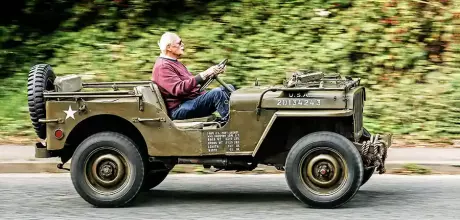1942 Willys Jeep
With formative memories of the post-war period, David Blunt has always had a soft spot for the Willys ‘Jeep’/ Ford GPW. Over 70 years since his first sight of one as a boy, will a hand-to-hand encounter with this wartime relic prove liberating, or require Blitz-spirit endurance?
Words JJ VOLLANS
Photography TOM CRITCHELL
One reader feels the weight of history in agenuine WWII Willys Jeep
The List Reader David Blunt owes his freedom to the Willys Jeep. We arranged a drive
‘Popularity has heaped attention on BMW, but these have avoided speculators’
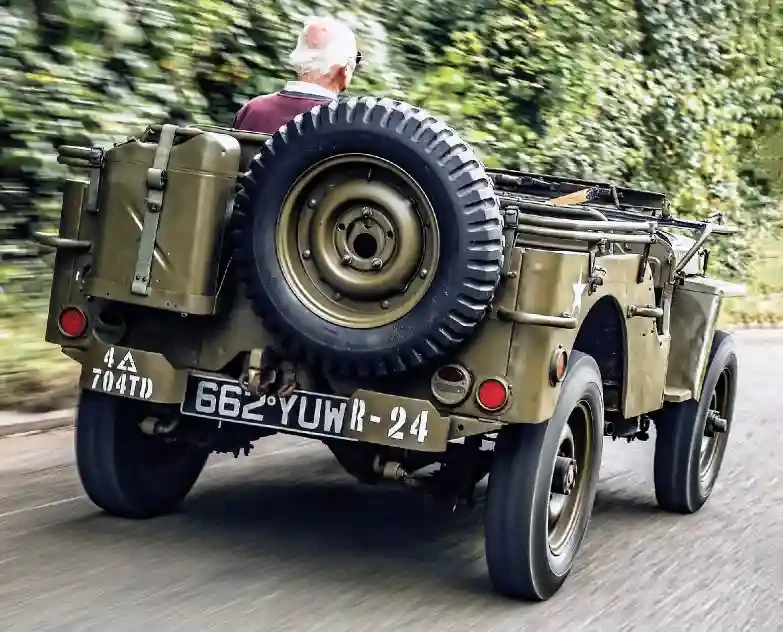
I meander along pretty lanes through earlymorning mist that’s covering some of the more bucolic scenes Gloucestershire has to offer; tantalising glimpses of the landscape hide all traces of the modern world. The impression of time stood still is palpable, yet the sight of CC reader David Blunt’s Nissan 350Z, parked outside my farmyard destination, pops the illusion in a good way. After admiring his choice of daily driver, I find the 81-year old former chemical engineer leant over the bonnet of the synchronously aged, instantly recognisable utilitarian machine we’ve arranged for him to drive.
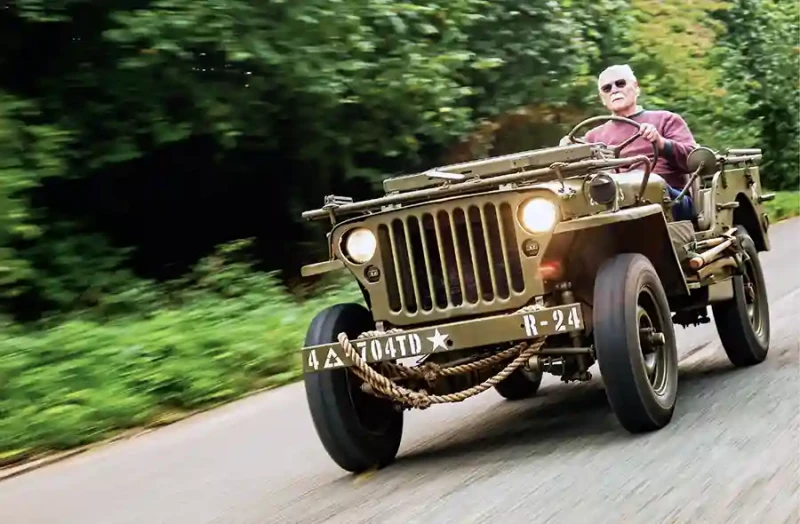
David hails from the west of the UK, so only had to nip a county over to meet us. ‘I’m from Bewdley in Worcestershire on the river Seven,’ he reveals over a cup of tea. His car history is pretty varied and interesting, starting out with British-built favourites like the Mini and Austin Maxi, before graduating to a company Ford Sierra and later a TVR 3000M. Yet, through all those, interest in one machine remained ever-present. ‘The wartime fascination really comes from my first memories,’ explains David. ‘Around 1946-1947 I was about five. Even though it was over, I remember everything was still about the war, from rationing and villagers coming home from service to our lessons at school; it was embedded in the culture. The Jeep was therefore an icon. I could hire a Ferrari if I wanted, but it’s not so easy to get behind the wheel of a wartime Jeep.’
The ‘Jeep’ was technically the General-Purpose Willys US Army Truck 1/4-ton 4x4 command reconnaissance vehicle. Understandably, GIs soon ditched this convoluted moniker, simply referred to their faithful four-wheeler as the Jeep. That name’s thought to have come about either because the sound of GP – for General Purpose – or, more likely, from the Popeye character Eugene the Jeep. The latter, a supernatural creature first seen in a 1936 comic book, could perform impossible feats, something servicemen witnessed their Jeeps doing daily.
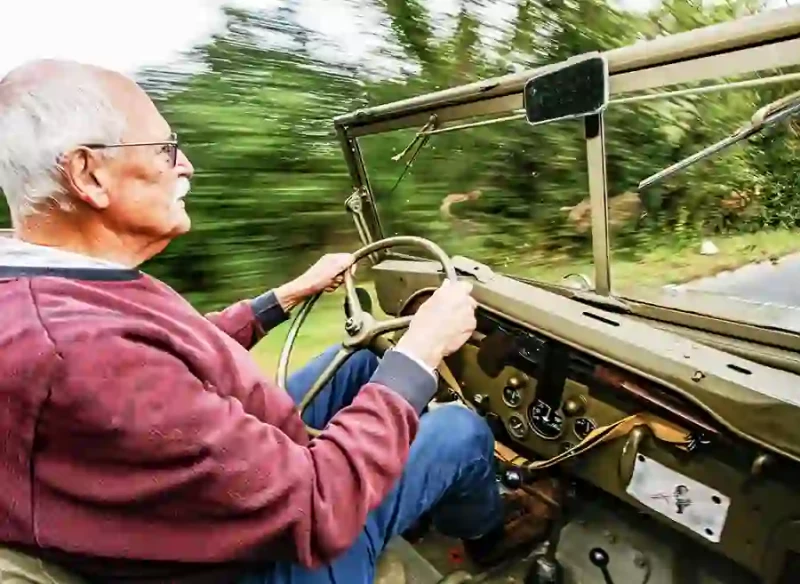
This one’s a 1942 Ford GPW, a licence-built Willys, and comes courtesy of its accommodating owner Richard Shepherd who, together with his father, collects military vehicles. The little offroader holds a special place in the Shepherds’ collection. ‘The Jeep was one of our first military vehicles,’ explains Richard. ‘My grandfather and father were both in the motor trade, so I grew up surrounded by old cars.’ Richard, in his mid-thirties, has taken this GPW on all manner of excursions, several back to former battlefield sites. ‘We’ve had this one for about ten years and regularly take it on the Belgian Military Vehicle Trust’s Winter Rally, which commemorates the Battle of the Bulge.’ Though this Jeep never saw frontline action, having been kept in the ’States on a military base and imported to the UK around 15 years ago, it’s nevertheless decked out with all manner of period wartime paraphernalia. That includes a deactivated genuine Thompson submachine gun, a US version of a Jerry can on the rear, and an entrenching tool – shovel to you and me – lashed to the side. It’s clear Richard takes pride in getting the period details correct and that attention to wartime authenticity resonates with David. ‘I can’t believe what those young men and women experienced. How would they have felt? I find it very emotional to think of what they did and, at the end of the day, we are here doing what we’re doing because of them.’
With mugs empty, intros over and mist burning off fast, David enters the Jeep’s driver’s seat; no mean feat, it’s quite high off the ground. He manages it with the spring of a young man, excitement clearly providing impetus. Beyond that, David defies his years with a cheery outlook, energy and enthusiasm. As he twists the dash toggle and hits the Jeep’s floor starter, the eagerness with which the side-valve L-head 2.2-litre engine fires without hesitation is testament to Richard’s maintenance; its Carter single-choke carburettor feeding an ideal fuel/air mixture, resulting in a rock-steady idle.
Encouragement and instruction are provided in equal measure by Richard from the passenger seat as David lets the Jeep loose. His first impressions, ‘The steering’s very direct, but also fairly vague.’ Oxymoronic as that might seem, this Jeep’s cam-and-twin lever system is antiquated by modern standards, though Richard’s made sure it’s free of as much play as possible. Though that doesn’t mean you can rely on it to plot a true course; plenty of minor corrections are needed. This isn’t just David’s first Jeep experience, it’s his first drive sitting on the left-hand side of the cabin. He also has to deal with unassisted steering and brakes, next to no bodywork and a dogleg threespeed transmission. Despite this, there’s no hint of nerves.
As familiarity with the Jeep sets in there’s time for a little conversation, admittedly at raised volume to be heard above the roar of the wind and tyres, and whine from the driveline. David’s easy manner and wit somewhat mask his fascinating work history, having had a hand in both Concorde and DeLorean projects. ‘For 25 years, I worked for other people on all sorts of jobs, mainly in production.’ He recalls working with some historic names in UK manufacture. ‘We did some work for John DeLorean way back – powder coating the gullwing door hinges – until he ran out of money. we also did some work for Concorde with Triplex on the glass. I then did 25 years as a freelance. I always described myself as an odd-job man.’
Clearly David’s in-sync with the Jeep, so Richard is able to share some of his own experiences with this four-wheeled warwinner. ‘The first Jeep I had was on L plates,’ he recalls. ‘My view is that any vehicle should only need 30 seconds to get used to.’ It’s clear from the way David’s negotiating the lanes along our route that he’s got used to this one and, from the beaming smile on his face, the experience seems to be living up to his long-held hopes. ‘It’s brilliant, just what I’d expected,’ he enthuses between measured gear changes. ‘You’ve just got to be respectful.’
With that said, David’s first big test presents itself, a poorlysighted crossroads of a busy A-road, which calls for a quick, clean getaway. ‘Because you’re sitting so high and looking more out than through, other than remembering where first gear is, it’s a piece of cake,’ enthuses David as he aces the crossing. ‘The engine’s remarkable too. It’s a major element of this driving experience. The low-down torque delivery is impressive.’ David’s less bowled over by the performance of the Jeep’s unassisted nine-inch drum brakes, which do a just about adequate job of reigning in the car’s 1040kg mass. ‘The lack of a servo is a bit of a culture shock. I think I’d have to have the brakes upgraded if it were mine!’ The Jeep’s three gears are short, which helps add to the sensation of urgency, but there’s no denying it’s far happier building speed than losing it.
‘They’re just a fun thing to drive in the way they go and handle,’ remarks Richard. ‘Bouncing and vaguely wandering in the direction you suggest.’ David agrees, ‘It’s a light vehicle, so it’s not going to take much power to shift, but the sensation of eagerness is great, you just let up the clutch and off it goes.’
On our way back to Richard’s farm, we’re once again negotiating tight B-road bends and even have to perform a turn in the road because of unexpected roadworks, both of which highlight another Jeep shortcoming. ‘We’re so wimpy these days with power steering, but you certainly notice its absence here!’ according to David. ‘It drives like a vehicle made up of 80-yearold technology, of course, but it’s all simple, user-friendly tech.’ Crucial when you need to get in and out of a hotspot in combat, which is what this vehicle was ultimately designed to do – something David’s clearly not overlooked. ‘The big thing for me is the thought that there were five men, kitted up, driving these things across Europe being shot at.’ Suddenly, there’s a more sombre tone. ‘There’s no way we can understand what they went through.’
Back on the same routes that earlier were veiled by mist, a bright sunny day has broken through the gloom, somehow offering a summary of the Jeep’s career. It might have started off in dark and uncertain times, where necessity drove invention but, since the war, it’s emerged into the light, become arguably the most recognisable off-road vehicle on the planet. From safaris to surfing, the Jeep in its many incarnations has brought the joy of go-anywhere transport to millions and even spawned its greatest rival, the Land Rover. Back in its paddock, with the engine off, there’s time for David to reflect upon his inaugural Jeep experience. ‘I wouldn’t have missed it for the world. I thought it was going to be fun but not this much. We’ve had a good mix of people and personalities and laughed and joked, but the underlying seriousness of it all was clear. Memories are what it’s all about and we’ve made a few today.’ On the driving experience specifically, David is typically self-effacing. ‘I did select reverse twice instead of first, but in spite of that, we got back okay. I never even thought about it being left-hand drive either. It was certainly an experience and what’s made it special for me is that we’re all still alive! I enjoyed it ten times more than I thought I would, it was great fun.’
David’s being modest. He soon got to grips with the Jeep and was confident and accurate behind the wheel. I was in awe of his get-up-and-go attitude, which proved inspiring and I can only hope to have half of his energy and positive outlook if I make it to 81. Equally, Richard is everything we could have hoped for from an owner – patient, calm and hugely knowledgeable.
He gives a final comment on the Jeep’s excellent and troublefree performance, ‘I’ve constantly fiddled with it. I’ve tinkered with the springs to level it out; in photos from the war they can be seen leaning to the left for some reason. I rebuilt the carburettor; I’ve also done various bits of wiring. Basically, things that I’ve broken by driving and abusing it. We haven’t had to do anything big in the mechanical sense, just maintenance.’ Considering the amount of use and abuse – to use Richard’s own words – this 81-year-old puts up with, it shows just how right the initial design was. But does it retain its place in David’s top ten? ‘It’s a most impressive piece of machinery designed for a purpose and was more fun than I had reckoned on. Top 5 now.’

This Jeep might be spared continent-liberating duties these days, but it still seems to thrive on being used.
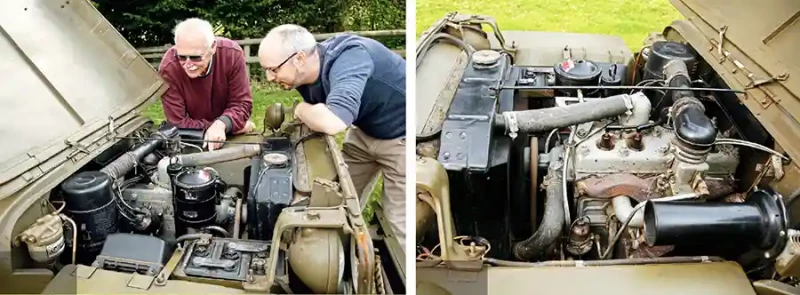
David and writer JJ pore over the 2.2-litre four-cylinder ‘L-head’ Starts on the button, and provides 105lb ft from 2000rpm.
TECHNICAL DATA 1942 Willys Jeep
- Engine 2199cc inline four-cylinder, side-valve (L-head), Carter W-O single-choke downdraft carburettor
- Max Power 60bhp @ 4000rpm
- Max Torque 105lb ft @ 2000rpm
- Transmission Three-speed manual, four-wheel drive
- Steering Unassisted variable-ratio cam-and-twin lever
- Suspension Front: independent with leaf springs, telescopic dampers and live axle. Rear: independent with leaf springs,
- telescopic dampers and live axle
- Brakes Nonservo assisted 9in drums
- Performance Top speed: 65mph
- 0-60mph: 24sec
- Weight 1040kg (2293lb)
- Fuel consumption 18mpg
- Cost new $1090 (based on civilian CJ-2A in 1945)
- Classic Cars Price Guide £11,000-£32,000
‘We’re so wimpy these days with power steering – you certainly notice its absence here’
David familiarises himself with placement of handbrake and other controls. Steering prefers rolling road wheels and needs some muscle.
Enthusiast-owned Jeep and CC reader John were both born in 1942. The most extreme optional extra these pages have ever seen.
‘I could hire a Ferrari if I wanted, but it’s not so easy to get behind the wheel of a wartime Jeep’


